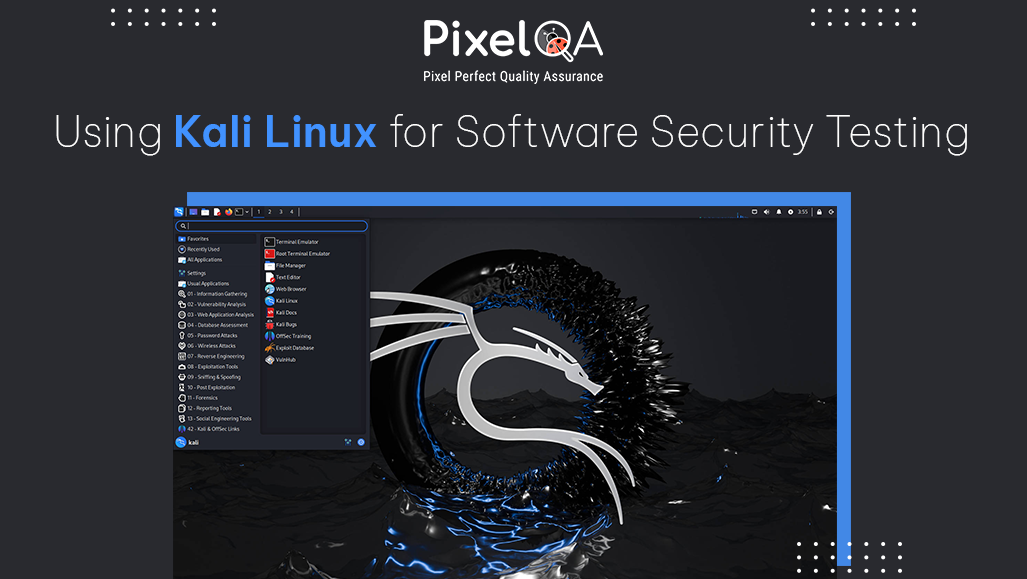
In cybersecurity, Security Testing Services including Manual Penetration testing, Automation Penetration testing, or moral hacking, is a vital preparation for distinguishing and settling shortcomings in frameworks and systems. With built-in tools specifically designed around VAPT, Kali Linux is the real number one security framework for security professionals. In this guide, we will cover the basics of penetration testing with Kali Linux, including both manual and automated approaches.
Table of Contents
- What is Penetration Testing?
- Why is Kali Linux Preferred for Software Security Testing?
- Getting Started with Kali Linux Penetration Testing
- Manual Penetration Testing
- Automated Penetration Testing
- Combining Manual and Automation Testing
- Best Practices for Security Penetration Testing
- Conclusion
What is Penetration Testing?
Penetration testing includes a wide range of attacks against a system aimed at locating and fixing security violations before a hacker can exploit it. This would be more like an intrusion into the organization or system that is meant to expose threats and improve security in general.
Why is Kali Linux Preferred for Software Security Testing?
Kali Linux is planned for security testing services and incorporates different tools for Penetration testing. Here’s why numerous specialists favor it:
1. Pre-Installed Tools: Kali Linux includes a wide range of tools for Penetration testing. Such as Network Scanning and Vulnerability Assessment.
2. Open Source: Kali Linux is free to utilize and always overhauled by an expansive community of engineers.
3. Customizable: Clients can customize Kali Linux by including or evacuating devices to meet their testing needs.
Getting Started with Kali Linux Penetration Testing:
Download and Introduce: Kali Linux has its own official website where you can download and install the latest versions. You can introduce it on your computer and run it from a virtual machine.
Explore the Interface: After establishment, get to know the Kali Linux interface. Browse the different tools accessible in the applications menu.
Before starting any penetration testing, make a controlled test environment. This may be a virtual machine or a devoted test organizer where you have consent to conduct security tests.
Manual Penetration Testing
Manual Penetration testing includes utilizing devices and strategies to discover vulnerabilities physically. This approach is frequently detailed and requires a deep understanding of the frameworks you are testing. Here’s a step-by-step guide.
1. Information Gathering: The first step is to assemble data about your target. This involves recognizing IP addresses, open ports, and administrations running on the target framework. Devices like Nmap and Netcat can be utilized for filtering and identification.
2. Scanning and Count: Once you have fundamental data, you need to dig in more. Utilize software like Nessus or OpenVAS to check for vulnerabilities. This step involves finding weaknesses in the system that could be exploited.
3. Exploitation: After vulnerabilities are discovered, the next step is to attempt to exploit them. Tools such as the Metasploit Framework can be used to exploit these vulnerabilities by simulating attacks to establish whether the vulnerabilities do in fact present any exploitable means.
4. Post-Exploitation: After the breach has been confirmed, the amount of a compromise should be assessed. This consists of checking for sensitive information, maintaining persistence, and assessing possible impact. Tools such as Meterpreter (part of the Metasploit) would be useful in this phase.
5. Reporting: Archive your discoveries in a nitty gritty report. Incorporate data on vulnerabilities found, how they were abused, and proposals for remediation. This report is pivotal for making a difference for organizations to settle the issues you found.
Automated Penetration Testing
Automated Penetration testing employments software and scripts to conduct tests with negligible manual mediation. This approach can rapidly recognize common vulnerabilities and is frequently utilized to complement manual testing. Here’s how to get begun:
1. Automated Checking: Use Automated tools to check for vulnerabilities. Nessus and OpenVAS can perform computerized powerlessness evaluations, giving a list of potential issues without requiring broad manual exertion.
2. Web Security Testing: Tools like Burp Suite and OWASP Destroy can test web security testing for common security issues such as SQL infusion, cross-site scripting (XSS), and unreliable arrangements.
3. Network Checking: Tools like Nmap can be arranged to run computerized checks on a plan. This helps in continuously monitoring systems for new vulnerabilities or changes.
4. Reporting and Investigation: Computerized apparatuses regularly create reports summarizing discoveries. Whereas these reports give a great outline, it’s fundamental to survey and analyze them physically to guarantee precision and setting.
Combining Manual and Automation Testing
For the best outcome, combine manual and computerized Penetration testing:
1. Start with Computerized Checking: Utilize mechanized tools to rapidly recognize common vulnerabilities and potential issues. This gives a wide diagram and spares time.
2. Follow-up with Manual Testing: Explore the vulnerabilities found by automated tools in more detail. Manual testing permits for more nitty gritty investigation and approval of issues.
3. Continuous Enhancement: Regularly undertake periodic upgrades of all your testing tools and methodologies. Such is the continuous evolution of cyber threats that keeping abreast of the newest tools and methods adopted becomes imperative.
Best Practices for Security Penetration Testing
1. Get Authorization: Always make sure you have explicit permission to test the systems or networks. Unauthorized testing is untrustworthy.
2. Keep Records: Archive all stages of the infiltration test, counting apparatuses utilized, strategies connected, and discoveries. This documentation is imperative for making reports and making strides in future tests.
3. Stay Moral: Penetration testing should be conducted morally, focusing on improving security rather than causing harm. Always follow ethical guidelines and legal requirements.
4. Regular Testing: Routinely perform infiltration tests to keep up with advancing dangers and keep up a solid security posture.
Conclusion
Kali Linux is very effective from a penetration testing perspective in discovering and eliminating security vulnerabilities. You can study and help improve your systems' security through manual testing and automated test procedures. Whether you’re an experienced professional or just starting out, Kali Linux gives the devices and adaptability required to conduct intensive and successful Penetration tests. Continuously keep in mind to conduct tests morally and with appropriate authorization and remain committed to nonstop learning and advancement in cybersecurity.
About Author

Rushi Mistry is a Security Tester at PixelQA a Software Testing Company with a focus on cybersecurity. He is passionate about IoT penetration testing and is working towards obtaining a CISSP certification, with the ultimate goal of becoming a Chief Information Security Officer (CISO).

_638621759562900363.png)
_638621759563279733.png)